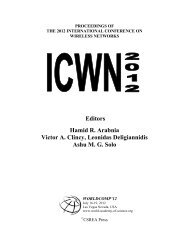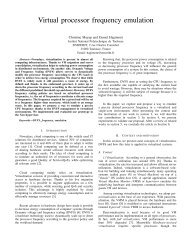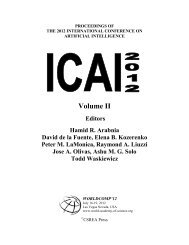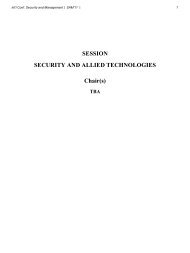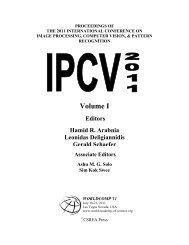SESSION NOVEL ALGORIHMS AND APPLICATIONS + ...
SESSION NOVEL ALGORIHMS AND APPLICATIONS + ...
SESSION NOVEL ALGORIHMS AND APPLICATIONS + ...
You also want an ePaper? Increase the reach of your titles
YUMPU automatically turns print PDFs into web optimized ePapers that Google loves.
14 Int'l Conf. Foundations of Computer Science | FCS'11 |<br />
Fig. 6: The theoretical and experimental number of cache misses for linear probing.<br />
Fig. 7: The expected number of cache misses for linear probing and uniform hashing for different load factors for B = 2, 4, 8.<br />
equations (6) and (7) this load factor can be obtained. In<br />
the typical operation region of α ∈ [0.3 0.8], linear probing<br />
has lower expected cache miss count even when B = 2.<br />
This is confirmed by the execution times as well.<br />
In general, when choosing a hashing algorithm, one<br />
should consider the parameters of the hash table and memory<br />
architecture, namely parameter B should be determined and<br />
the operational load factor should be decided.<br />
Generally, our conclusion is that the simple algorithmic<br />
step count based raking of algorithms, especially for<br />
algorithms that intensively use memory, is not sufficient.<br />
The physical capabilities of the machine that executed the<br />
algorithms should be taken into consideration, and with<br />
integrating the memory model into the cost function, a better<br />
efficiency comparison can be derived.<br />
5. Conclusion<br />
Hashing algorithms are usually ranked by their expected<br />
probe lengths. It has been our observation, and also published<br />
in the literature, that this is not always true. Based<br />
on previous works we know that in case of open-address<br />
hashing the performance of the algorithm is greatly effected<br />
by its memory characteristics.<br />
We have shown that the expected probe path based efficiency<br />
comparison is not fair for linear probing, which<br />
is generally though of as an inferior choice of hashing<br />
scheme. Under real-life circumstances, however, it is able to<br />
outperform more sophisticated hash tables, such as double<br />
hashing.<br />
Incorporating the effect of cache lines into the cost function<br />
of hashing algorithms we have presented a novel model<br />
of evaluation. This approach models the true performance of<br />
these hash tables more precisely.<br />
Acknowledgment<br />
This project is supported by the New Hungary Development<br />
Plan (Project ID: TÁMOP-4.2.1/B-09/1/KMR-2010-<br />
0002) and by the fund of the Hungarian Academy of Sciences<br />
for control research, the Hungarian National Research<br />
Fund (grant number T68370).<br />
The authors express their thanks to Sándor Juhász for his<br />
help as scientific advisor.<br />
References<br />
[1] G. H. Gonnet, “Expected Length of the Longest Probe Sequence in<br />
Hash Code Searching,” Journal of the ACM, vol. 28, no. 2, pp. 289–<br />
304, Apr. 1981.<br />
[2] M. V. Ramakrishna, “Hashing practice: analysis of hashing and<br />
universal hashing,” ACM SIGMOD Record, vol. 17, no. 3, pp. 191–<br />
199, Jun. 1988.<br />
[3] A. Pagh, R. Pagh, and M. Ruzic, “Linear probing with constant independence,”<br />
Proceedings of the thirty-ninth annual ACM symposium<br />
on Theory of computing - STOC ’07, p. 318, 2007.



